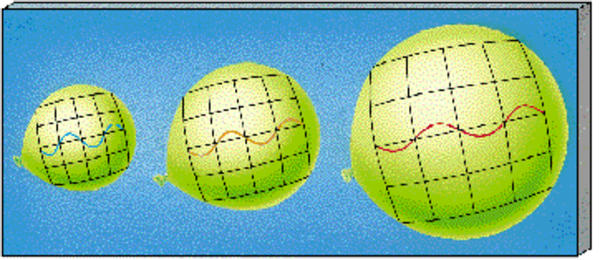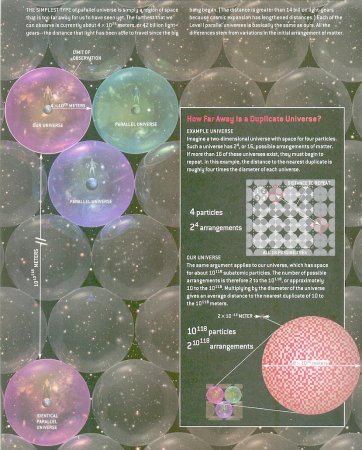Time Travel Research Center © 2005 Cetin BAL - GSM:+90 05366063183 - Turkey / Denizli
The Observable Universe
Contents
The Observable Universe
Big Bang Theory
Dark Energy, Dark Matter
Parallel Universes, Multiverse - the Unobservable Universe
Footnotes
References
Index
The Observable Universe
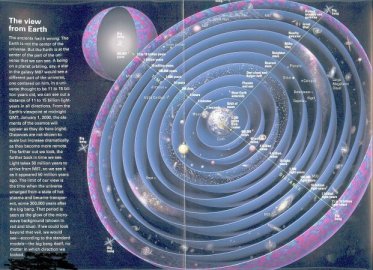 |
The observable universe is the space around us bounded by the observable horizon - the distance to which light can have traveled since the universe originated. This space is huge but finite with a radius of 1028 cm. There are definite total numbers of everything: about 1011 galaxies, 1021 stars, 1078 atoms, 1088 photons. There is a hierarchy of structure: Everything is composed of smaller things and is a part of something larger as shown in Figure 02-01 and Figure 15-01. The character of structures with different scale changes according to the interplay of various physical forces. Quantum phenomena control the small scales, while gravity dominates on large scales, and both come into play at the beginning of the universe. On each scale of size there is a corresponding scale of time: processes tend to happen quickly on small scales and slowly on large scales. |
Figure 02-01 The Observable Universe |
Big Bang Theory
This phenomenon is called red shift of the spectrum because in visible light the shift to longer wavelength is toward the red colour. It plays a prominent role in discovering the cosmic expansion through the detection of the spectral line shift from distant galaxies.
This simple picture of expanding universe with all the galaxies flying away from each other remained unchanged until 1980s when the Inflation Theory was introduced to resolve a number of discrepancies. The rapid expansion occurred at the interval between 10-35 sec and 10-33 sec. It predicts a much smaller universe near the origin of the Big Bang such that the matter-energy within can be mixed evenly as reflected in the CMBR mapping. It also predicts that the geometry of the Universe is flat. Events before the inflation is essentially unknown. It is subjected to a lot of speculations. For example, it is suggested that space-time may be created from vacuum fluctuation - the quantum foam; and that the four fundamental forces may be unified to just one kind (as envisioned by the theory of superstrings). Baryongenesis (generation of quarks and anti-quarks which has a baryon number of 1/3 or -1/3) happened in an epoch before inflation, when a imbalance between matter and anti-matter was established by a quantum process called CP violation. Quarks and anti-quarks combined to form baryons and mesons at 10-5 sec. Nucleosynthesis started at about 3 min. During this epoch the light chemical elements were produced from protons and neutrons. The universe was still opaque up to 380,000 years when neutral atoms started to form and the radiation was able to escape as shown by the CMBR. This epoch is called decoupling to indicate that matter and radiation are separated. From then on matter had a chance to condense into stars and galaxies and evolved to the present-day universe. Figure 02-03 shows the history of the universe according to the Big Bang Theory.
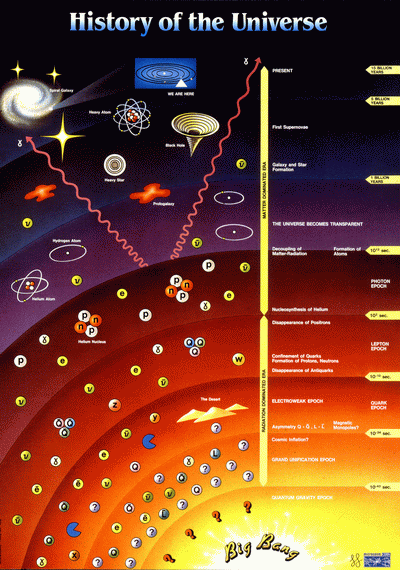 |
Supplement to the legend of Figure
02-03: The quark (q), electron (e), and neutrino (n) are the fundamental particles. The corresponding anti-particle is labeled with a bar on top. The gluon (g) is the boson mediating the strong interaction between quarks. The vector bosons W and Z mediate the weak interaction between electrons/neutrinos and the quarks. The photon (wavy line) mediates the electromagnetic interaction between charged particles. One quark and one anti-quark combine to form a meson. Three quarks combine to form a baryon (proton, neutron, etc.). Protons and neutrons combine to form nucleus (ion). Nucleus and electrons combine to form atom. The muon (m) and tau (t) are the 2nd and 3rd generation of the lepton family, the 1st generation is the electron. (See more about elementary particles in Topic-15.) |
Figure 02-03 History of the Universe |
There are scales for the time t (in second), temperature T (in oK)
and energy E (in Gev) at the bottom of Figure 02-03. These variables are
related by the simple mathematical formulas:
E(Gev) = 10-3 / t1/2(sec), and E(Gev) = 10-13
x T(oK)
There is no such simple formula for the size of the observable universe and
these variables. Its relationship with time can be plotted in a
graph.
Table 02-01 depicts the sequence of events after the Big Bang in time order.
The relics and observables are physical facts, while the interpretations of
the events are mostly theories or conjestures.
| Era | Time | Size (observable) |
Energy or Temperature |
Relics & Observables | Events |
|---|---|---|---|---|---|
| Planck era | < 10-43 sec | < 10-33 cm | > 1019 Gev | 4-dimensional spacetime; cosmic expension |
Smallest unit of space-time started to expand |
| GUT era | < 10-36 sec | < 10-25 cm | > 1016 Gev | Super-heavy particles; fundamental interactions | Separation of spacetime and mass; gravit-ational, strong, and electroweak forces |
| Inflation | < 10-34 sec | < 1 cm + (unob- servable extent) |
> 1014 Gev |
Observable universe; large scale structures |
Unstable vacuum; quantum fluctuations |
| Electro-weak era | < 10-10 sec | < 1012 cm | > 100 Gev | Radiation; excess of matter over antimatter; separation of force and matter fields |
Radiation released in reheating; baryon-antibaryon asymmetry; separation of weak and electromagnetic forces, origin of mass |
| Strong era | < 10-4 sec | < 1016 cm | > 200 Mev | Exotic forms of dark matter | Formation of hadrons from quarks including neutrons and protons |
| Weak decoupling | < 1 sec | < 1018 cm | > 1 Mev | Hydrogen nuclei domination | Neutrinos decouple, neutron/proton ratio fixed |
| e-e+ Annihilation | < 5 sec | < 1019 cm | > 0.5 Mev | Photons hotter than neutrinos today | Electron heat dumped into photons |
| Nucleo-synthesis | < 100 sec | < 1020 cm | > 100 Kev | Light element abendances: D, He, Li | Nuclear reactions freeze out, stable nuclei form |
| Spectral decoupling | < 106 sec | < 1022 cm | > 500 ev | Blackbody background radiation | End of efficient photon production |
| Matter ~ radiation | < 104 yrs | < 1024 cm | > 3 ev | Mass density fluctuations | Matter density ~ radiation density |
| Recom-bination | < 0.3 My | < 1025 cm | > 3000 K | CMBR | e- and p+ recombine into H atoms, universe transparent to light |
| Dark ages | < 1 Gy | < 1027 cm | > 20 K | First stars, heavy elements | mass fluctuations grow, first small objects coalesce, reionization |
| Galaxy formation | < 2 Gy | < 2x1027 cm | > 10 K | Stars, quasars, galaxies | Collapse to galactic system |
| Bright ages | < 13 Gy | < 1028 cm | > 3 K | Milk Way and Solar System | Gas consumed into stars, remnants, planets |
| Present era | ~ 13.7 Gy | ~ 1028 cm | ~ 2.73 K | Supercluster | Large scale gravitational instability |
Table 02-01 A History of Cosmic Expansion
In an effect to learn more about the processes occurred in the early universe, which was associated with very high energy as shown in Table 02-01. Particle Physicists have been simulating the condition in the laboratory with high energy particle accelerators (see the entries in top left of Figure 02-03). In collaborating with the theory of elementary particles, experiments are developed to investigate the creation of fundamental particles, and their properties. A list of the major accelerators in the world is shown in Table 15-01.
- The Night Sky : It is referred to as the Olber's Paradox. He posed the question way back in 1823. According to his calculation, the night sky would glow brightly from all the stars if the universe is infinite both in space and in time. Obviously, this is not true. The paradox is resolved by the Big Bang Theory which limits the observable horizon to about 1028 cm. and an age of about 14 billion years. In addition, the light from remote objects is also diminished by the red shift of the spectrum.
- The Red Shift : It was discovered in the 1920s that Andromeda and other similar smears of light were akin to our own Milk Way Subsequently, it was noticed that more distant galaxies are receding faster than those nearby - an observation that could be explained if the universe were expanding. The speed of recession is measured by red shift of the spectral lines. The distance is measured by standard candle such as the class of stars known as Cepheid Variable which, possesses an unique relationship between the period (of brightness variation) and its intrinsic luminosity. The speed-distance relation is known as the Hubble's law. It is a very simply formula equating the speed v to the distance d, i.e., v = Ho x d, where Ho is the Hubble's constant. It has a value of 71 (km/sec)/Mpc according to the latest measurement by WMAP.
- Nucleosynthesis : The universe's light-element abundance is another important criterion by which the Big Bang Theory is verified. It is now known that the elements observed in the Universe were created in either of two ways. Light elements (namely hydrogen, deuterium, helium, and lithium) were produced in the first few minutes of the Big Bang, while elements heavier than lithium are thought to have their origins in the interiors of stars which formed much later in the history of the universe. The relative abundances of the light atomic nuclei has been calculated as a function of the average density of the universe. There is a convincing coincidences between the observed and calculated values at a density of 3x10-31 g/cm3. This density implies an open universe, which will keep on expanding forever. Such conclusion seems to be in contradiction with the Inflation Theory which predicts a flat universe at the critical density of 10-29 gm/cm3. This problem may be resolved by the presence of "dark matter".
- Cosmic Microwave Background Radiation : See section on WMAP.
- Hubble's Deep Field Survey : The Hubble Space Telescope (HST) was launched on April 24, 1990. Since then it has collected photographs of various celestial objects in astonishing details. One of the photos called Hubble Deep Fields has captured astronomical objects from nearby star to some immature galaxies near the beginning of the Big Bang. We are able to sample different epochs in the photo because light from the nearer objects reaches us sooner than from those further out (because light propagates with a finite speed of 3x1010 cm/sec). The objects in the photo can be separated by redshift into a series of images corresponding to different epochs. It unveils a universe that is steadily changing over time, just as the Big Bang predicts.
The following is a summary of the evidences which support the validity
of the Big Bang Theory.
Dark Energy, Dark Matter
It seems that the Big Bang Theory has been validated conclusively with all these supporting evidences. However, recent observations in the last few years reveal that there is something amiss. It is noticed that even though there is not enough mass to hold the stars, galaxies and galaxy clusters in place, they are still moving around and would not disperse. It looks as if there is some kind of invisible force (gravity from the dark matter) to hold them together. The situation is similar to a puppet show, where the audience can safely assume that someone behind is manipulating the movements.
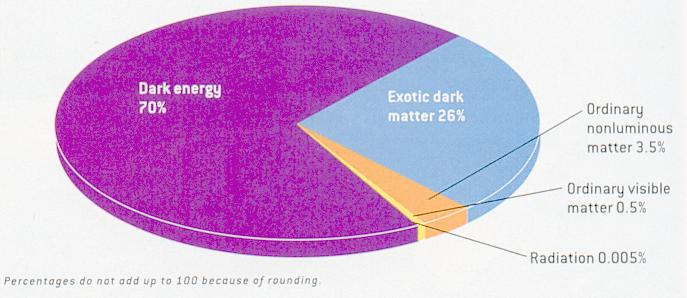 |
The second problem is related to the use of the Type Ia supernovae as "standard candles" to measure the distance of remote objects. The measurements imply that the cosmic expansion is accelerating. It is proposed that there is some kind of repulsive "dark energy" to induce the acceleration. Figure 02-10a shows the proportion of the various matter-energy components in the Universe. Most of the matter-energy content is in the form of "dark energy". The composition of the Universe is listed in Table 02-02 below. |
Figure 02-10a Energy-Matter in the Universe |
Acceleration of the cosmic expansion is placed on a firmer footing when it is observed in 2003 that the CMBR becomes slightly hotter after going through a galaxy, which forms a gravitational (potential) well. Dark energy, being gravitationally repulsive, makes a gravitational well shallower as a photon passes through, so the photon exits with slightly more energy than it had when it entered.
| Material | Representative Particles | Particle Mass or Energy (ev) | No. of Particles in Observed Universe | Probable Contribution to Mass of Universe | Sample Evidence |
|---|---|---|---|---|---|
| Ordinary (baryonic) matter | Protons, electrons | 106 to 109 | 1078 | 5% | Direct observation, inference from element abundances |
| Radiation | photons | 10-4 | 1087 | 0.005% | Microwave telescope observations |
| Hot dark matter | Neutrinos | < 1 | 1087 | 0.3% | Neutrino measurements, cosmic structure |
| Cold dark matter | Supersymmetric particles? | 1011 | 1077 | 25% | Inference from galaxy dynamics |
| Dark energy | Scalar particles? | 10-33 | 10118 | 70% | Supernova observations of accellerated cosmic expansion |
Table 02-02 Composition of the Universe
- Cosmological constant - Eistein had introduced a term with the cosmological constant in the gravitational field equation to keep a static universe from collapsing. This additional repulsive force is no longer necessary when the cosmic expansion became apparent. It has become fashionable again with the new discovery of cosmic acceleration. It is very tempting to identify the cosmological constant with the vacuum energy of the various quantum fields. However, the simplest versions of quantum theory predict far too much energy. One explanation involves the cancellation of all these fields (of vacuum energy) to almost zero, leaving only a residual trace corresponding to the observed dark energy.
- Quintessence - This hypothetical form of dark energy permeates all space. Like inflation, quintessence is thought to have somehow originated when the universe was just 10-35 sec old. It is driven by a scalar field whose energy varies gradually. The difference is the energy and time scale: inflation occurred quickly at very high energies, whereas the scalar field responsible for quintessence operates at much lower energies over a much longer time frame.
- Neutrino - It is a reasonable candidate for dark matter because of its unreactive nature. Theoretical calculations indicate that there should be as many as 100 million neutrinos for every atom in the universe. However, the recent estimates of neutrino mass is so slight that it could account for only about 0.1 - 7 per cent of the mass of the universe.
- WIMP - Many new particles with heavy mass appear in the supersymmetry formulation. These are referred to as weakly interacting massive particles, or WIMPs. For example, the photino (the fermionic partner of photon) has a mass about 10 to 100 times that of the proton. Most of these electrically neutral particles would, like neutrino, go straight through Earth. On rare occasion, however, one might interact with an atom in the material they pass through. So far, the only claimed detection of a dark matter particle (by an Italian team in 2000) has been strongly disputed.
- Nonluminous matter - Ordinary hidden matter consists of atoms that emit little or no light. It includes a host of celestial objects such as planets, dark gas clouds, brown dwarfs, neutron stars, and black holes. The Massive Compact Halo Objects Project (MACHO) has been looking for them in the halo of the Milky Way. A search for microlensing has turned up four candidates toward the Large Magellanic Cloud and 45 toward the Galactic Bulge.
- Minimal model - Since we don't feel the effect of dark energy and dark matter around us except through the gravitational influence on large scale, a model has been constructed with no noticeable interactions between each other or with ordinary matter. It fits the observational data such as the high-redshift supernovae, the microwave background radiation, the distribution of large-scale structure, and the dynamic of celestial objects very well. The dominance of dark energy and dark matter over ordinary matter indicates that human beings are extremely unimportant in the grand scheme of the universe as suggested in a 1985 movie called "Insignificance'' in which Einstein and Monroe explores relativity and our place in the universe.
- Future of the universe - It seems that the effect of dark energy
became dominant only recently about 8 x 109 years after the Big
Bang. If the acceleration presists in the future, it will impose a horizon
surrounding a galaxy like the Milkyway - a distance beyond which light
cannot reach us. Figure 02-10b depicts the sequence of events for the
future of the universe with cosmic acceleration according to a computer
simulation (click image to obtain larger view). The model assumes that the
dark energy permeating the vacuum has a positive, constant value - similar
to the cosmological constant, as Einstein once posited.
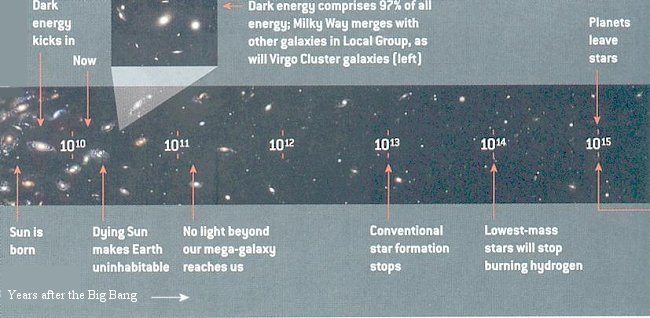
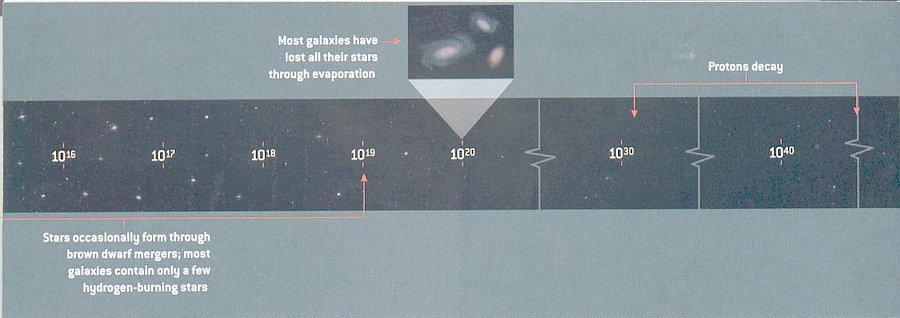
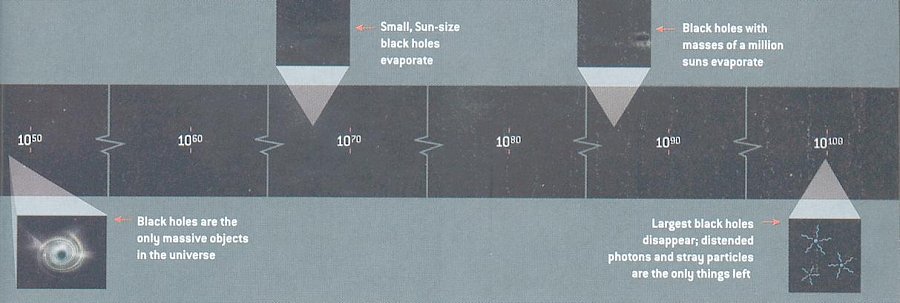
Figure 02-10b Future of the Universe
The nature of both the "dark matter" and "dark energy" is still the
subject of intense research observationally and theoretically. Some of the
suggestions are listed below:
Parallel Universes, Multiverse - the Unobservable Universes
The subject of parallel universes used to belong to the realm of science
fictions. The idea is familiar on some TV shows such as "Star Trek'', which portrays other worlds that are almost like our own, except
... there is a slight difference. Then some cosmologists propose that our
Universe might be just one of many in an ever-multiplying network of
parallel universes, which they call the
multiverse.
Recent observational data open up the possibility that it is conceivable
scientifically with some imaginative inferences.
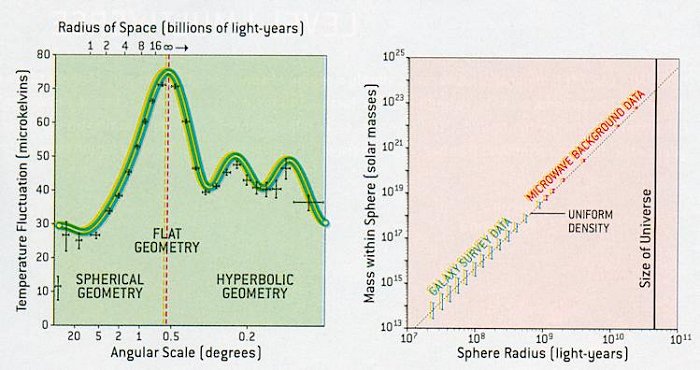 |
Figure 02-11 shows recent astronomical observations, which tend to support the hypothesis. The diagram on the left illustrates the WMAP measurement of the fluctuations in the CMBR temperature. The strongest fluctuations are just over half a degree across, which indicates that space is very large or infinite. In addition, the diagram on the right illustrates the measurements of matter density from WMAP and 2dF Galaxy Redshift Surveyc. They are consistent with uniform distribution of matter on large scales. |
Figure 02-11 Universe, Flat and Uniform |
|
- The radius of the observable universe is taken to be 4x1026 m. It is assumed that the matter in the universe consists of nucleons, which has a radius of about 2x10-13 m.
- Therefore, the universe has roughly 10118 partitions for the nucleons.
- These partitions can be filled or unfilled according to the configuration of the universe. The total number of different arrangements is 210118.
- A box with a radius of 210118x1026 m ~ 210118 m would exhausts all the possibilities. It contains possibly all kinds of parallel universes.
- Beyond that box, universes - including ours - must repeat. The identical parallel universe would be about 210118 m away as shown in Figure 02-12 (the number there has been "round off" to 1010118 meters).
Followings is a more elaborated deduction with simple mathematics:
There are even more exotic scenarios about multiverse:
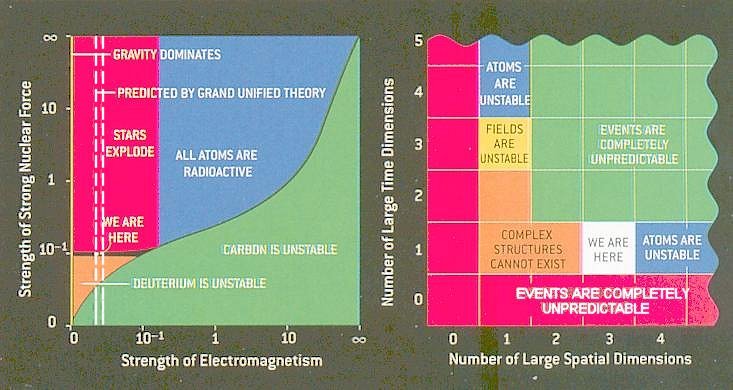 |
|
Figure 02-13 Anthropic Principle |
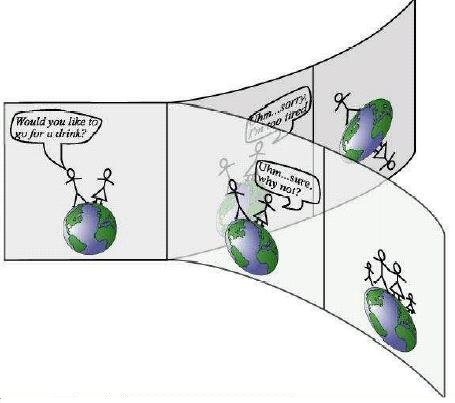 |
|
Figure 02-14 Quantum Worlds |
Footnotes
aSince the inflation has generated a much
bigger universe than we can see, the visible universe becomes flat to our
perception just like the flat Earth in local view. This implies parallel
lines will never meet no matter how far they are extended, and the familiar
scenery of galaxies and galaxy clusters would extend infinitely far beyond
our cosmic horizon.
bThe first peak (the whole curve) of the power spectrum moves
from left to right with increasing radius of space.
cThe 2dF redshift survey uses the two-degree field spectroscopic facility on
the Anglo-Australian Telescope to measure the redshifts of 250,000 galaxies.
- Big Bang Tour (animation) -- http://superstringtheory.com/cosmo/cosmo3.html
- Cosmology (lecture notes) -- http://blueox.uoregon.edu/~jimbrau/astr123
- Inflation -- http://www.ucolick.org/~patrik/ay5/notes/lecture15.pdf
- CMBR Spectrum -- http://archive.ncsa.uiuc.edu/Cyberia/Cosmos/Footprints.html
- CMBR Fluctuations -- http://pancake.uchicago.edu/~carroll/ourpreposterous/img19.htm
- CMBR Polarization -- http://www-news.uchicago.edu/releases/02/020918.carlstrom.shtml
- CMBR Polarization, DASI home page -- http://astro.uchicago.edu/dasi/
- CMBR Power Spectrum -- http://www.livingreviews.org/Articles/Volume1/1998-11jones/node2.html
- CMBR Power Spectrum (animation) -- http://background.uchicago.edu/~whu/intermediate/gravity.html
- Wilkinson Microwave Anisotropy Probe (WMAP), Home Page -- http://map.gsfc.nasa.gov/
- Dark Energy, Dark Matter -- http://hitoshi.berkeley.edu/290E/
- Parallel Universes, Multiverse -- http://www.hep.upenn.edu/~max/multiverse.html
References:
Index
Anthropic Principle Aristotle and Plato Big Bang Theory Black-body radiation CMBR fluctuations CMBR polarization CMBR power spectrum CMBR spectrum Composition of the Universe Dark energy, dark matter Decoupling epoch Future of the Universe History of the Universe Hubble's law Hubble's constant Hubble deep fields |
Hubble's space telescope Inflation Theory Loop quantum gravity Milky Way Multiverse Nucleosynthesis Observable universe Olber's paradox Parallel Universes Polarization Quantum Foam Quantum worlds Red shift Standard Candle Supernova type Ia Wilkinson Microwave Anisotropy Probe (WMAP) |
Wormhole, Time Travel, Time Machine, Zamanda Yolculuk, Zaman Makinası, Warp drive, UFO, Teleportation, Işınlama, Solucan deliği
Hiçbir yazı/ resim izinsiz olarak kullanılamaz!! Telif hakları uyarınca bu bir suçtur..! Tüm hakları Çetin BAL' a aittir. Kaynak gösterilmek şartıyla siteden alıntı yapılabilir.
The Time Machine Project © 2005 Cetin BAL - GSM:+90 05366063183 -Turkiye/Denizli
Ana Sayfa /index /Roket bilimi /![]() E-Mail /CetinBAL/Quantum Teleportation-2
E-Mail /CetinBAL/Quantum Teleportation-2
Time Travel Technology /Ziyaretçi Defteri /UFO Technology/Duyuru
